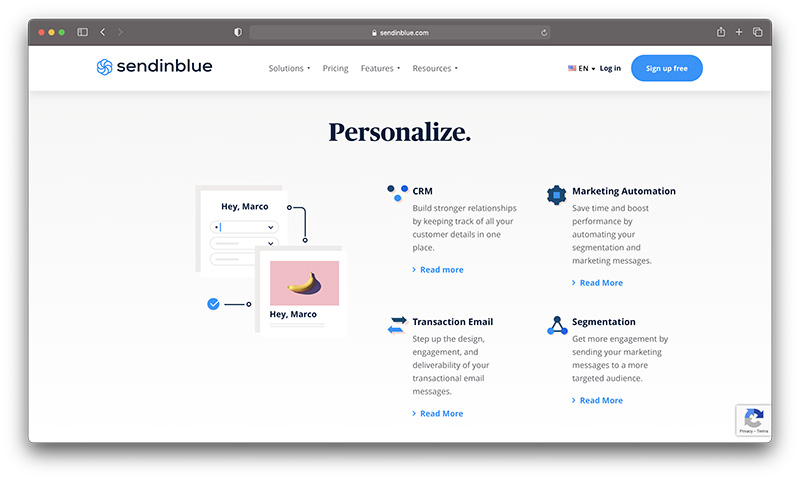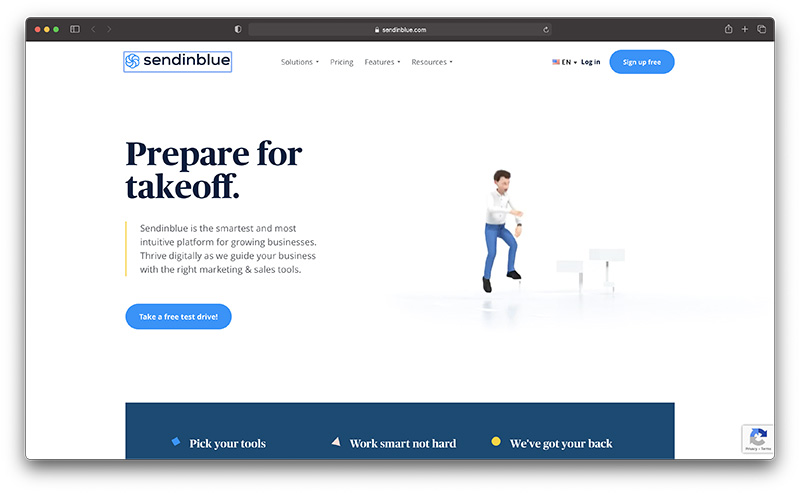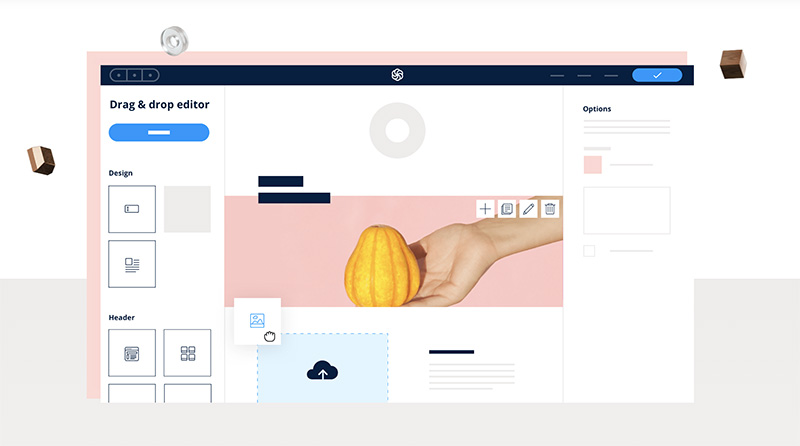Despite the multitude of ways companies can invest in marketing today, email advertising is still one of the most effective choices. Email give you a direct line to your target audience, ensuring that you can reach them when they’re at work, at home, and on the go. More importantly, with the right automated campaign, you can use your email strategy to nurture customers, and generate repeat sales.
Of course, handling all of the components of a full email campaign alone would be practically impossible – particularly as your business continues to grow. That’s why it’s crucial to have the right email marketing automation software in place.
Today, Sendinblue and SendGrid represent to appealing email marketing solutions, equipped with a host of features to transform your promotional efforts. Both of these tools are excellent at generating sales and building brand loyalty through sales funnels and templates.
But which is best?
Sendinblue vs SendGrid: An Introduction
Sendinblue started life as a budget-friendly email marketing service, but it’s evolved into so much more over the years. Now a complete digital marketing service, Sendinblue supports everything from CRM functionality, to SMS marketing, SMTP relay, and even live chat customer service.
Suitable for both transactional email and promotional messages, Sendinblue aims to make connecting with your customers as simple as possible. There’s A/B testing to help you generate the best results, great customer support, and a host of ever-improving functionality options.
👉 Read our comprehensive Sendinblue review.
SendGrid is another extremely popular service for those interested in email advertising. SendGrid remains focused heavily on email marketing, unlike Sendinblue.
This service has been around a little longer than Sendinblue and supports companies like Uber and Spotify. You can access email templates through this company, a dedicated IP address, real-time reporting and more.
👉 Read our comprehensive SendGrid review.
Sendinblue vs SendGrid: Pricing
There’s more to choosing the right marketing solution than budget. However, we all have pricing restrictions that we need to think about. Fortunately, both Sendinblue and SendGrid are relatively affordable tools.
Sendinblue has long had a reputation for offering some of the most affordable marketing solutions around. There’s a free plan to get you started, where you can send up to 300 emails per day, and you get to store unlimited contacts.
Other packages include:
- Lite: $25 per month for up to 100,000 emails, with no sending limit, email support, A/B testing, and the ability to access advanced statistics.
- Premium: $65 per month for up to 1,000,000 emails, marketing automation, retargeting and Facebook ads, multi-user access, landing pages, and telephone support.
- Enterprise: (Quote only) for everything you get in Premium, plus custom email volumes, priority sending, 20+ landing pages, access for another 10 users, SSO SAML, Customer success management, priority support and other features too.
👉 For more info check out our Sendinblue pricing guide.
If you thought that Sendinblue’s pricing structure was flexible, just wait until you see what you can get from SendGrid. The first selection of plans available is the email API SMTP plans. These start at $0 per month if you want access to delivery optimization tools, a template editor, analytics, ticket support and more. The free plan is suitable for up to 40,000 emails. Beyond that, your premium options include:
- Essential: $14.95 per month for 50,000 emails per month, you can also increase to 100,000 emails per month for $29.95 per month.
- Pro: $89.95 per month for up to 200,000 emails, and a dedicated IP address too. You can increase to up to $749 per month for more than 1.4 million emails.
- Premier: If you’re sending over 1.5 million emails, you’ll need to reach out to SendGrid for a custom quote.
Beyond the Twilio SendGrid functionality through API technology, you can also access plans for full marketing email suite solutions. Once again, there’s a free option here, for design and code editing, segmentation, A/B testing, signup forms, automation, and so on.
The premium plans include “Basic”, which starts at $15 per month depending on how many emails you want to send. The plan goes up to 100,000 contacts, and you can access around 300,000 monthly emails, for a cost of $200 per month. The Advanced package includes extra functionality, like automation and dedicated IP addresses. You can pay around $60 for this for up to 15,000 contacts, and around 50,000 emails per month. The plan increases to around $900 per month for 1 million emails, or 200,000 contacts.
The pricing for your SMTP access will depend on how many emails you hope to send. Marketing suite plans are based on your number of contacts and emails.
Sendinblue vs SendGrid: Email Templates and Editing
If you want to get the most out of your email marketing solutions, you need to ensure that you can create messages that look fantastic. A tool like SendGrid or Sendinblue will stop you from having to hire a professional designer to get the job done.
Through Sendinblue, you can get around 200 responsive templates for email, and although some are more attractive than others, there are enough options that you should be able to find something decent to use. If you don’t love the template immediately, you can also edit it with the drag-and-drop tool from Sendinblue too. This email builder is a little basic compared to some of the market leaders, but it is very easy to use.
With Sendinblue, you can check your what your emails are going to look like on a smartphone before you send them out too.
SendGrid takes a similar approach to emails and templates, with lots of free and premium options to choose from. There’s a set of easy-to-use design tools that allow you to customize everything according to your needs, and SendGrid’s templates cover a range of different kinds of emails too.
You can find messages specifically for order receipts or build dynamic transactional emails that change to show your customers what they’ve bought. This makes it easy to deliver a professional experience to your audience from day one.
SendGrid’s library of designs is constantly growing, and you can customize them with your logo, copy, and brand colors. There’s also the option to save a template and reuse it multiple times so you can maintain a consistent image with your customers.
All of the email templates from SendGrid are also responsive, so you know they’re going to be perfect on smartphone screens.
Sendinblue vs SendGrid: Features
At their core, Sendinblue and SendGrid are very similar. They’re both tools that help you to connect with your target audience and build better connections as a result.
The first thing you can do with both of these services is send and schedule emails. As shown above, there are tons of templates to choose from to get you started, and you can even customize those templates however you choose. SendGrid and Sendinblue are both great for helping you to send email blasts instantly, or automatically according to your chosen schedule.
With Sendinblue, however, you do have a little more capacity to schedule the emails that you want to send at the time that makes the most sense for you.
 From a marketing automation perspective, both of these tools allow you to create automated email sequences that completely responds to the behaviors and actions of your subscribers. When subscribers sign up for your newsletters, this could automatically trigger a welcome campaign, for instance.
From a marketing automation perspective, both of these tools allow you to create automated email sequences that completely responds to the behaviors and actions of your subscribers. When subscribers sign up for your newsletters, this could automatically trigger a welcome campaign, for instance.
The automation abilities of Sendinblue are a little more advanced than the ones in SendGrid. To help you get started as quickly as possible, Sendinblue offers a range of marketing automation templates, so you can basically copy and paste your content into an existing solution.
SendGrid has also added this functionality, but there aren’t as many sequence templates to choose from.
Features of SendGrid include:
- Automated campaigns
- Responsive templates
- Drag-and-drop or HTML editing
- Automated recurring emails
- Time-based series
- Reporting and analytics
- Proven deliverability
- Dedicated IP addresses
- Control of marketing and transactional emails
- Visibility of the entire email process
- Collaboration features
- Addons for email history
- Signup forms and landing pages
- Email testing and spam testing
- Excellent email statistics
- List management
Features of SendinBlue include:
- Email marketing
- SMS marketing
- Live chat functionality
- CRM customer support tracking
- Marketing automation
- Segmentation and targeted sending
- Transaction emails
- Landing pages
- Signup forms
- Facebook ad access
- Retargeting campaigns
- Click-through and open rate reports
- Email heat maps
- A/B testing
- Real time statistics
- Send-time optimization
- API access
- Plugins and integrations
Notably, both SendGrid and Sendinblue have contact management and segmentation features, but Sendinblue has it’s own built-in CRM functionality. You can import unlimited contacts with Sendinblue, whereas your functionality will depend on the pricing package you choose for SendGrid. You should also be able to access more best-in-class segmentation with Sendinblue
The advanced data you can access with Sendinblue means that you can customize your client’s experience based on their data, and their background. You can even optimize sending times.
Sendinblue vs SendGrid: Reporting and analytics
Reporting and analytics functionality in an email marketing tool helps you to ensure that you’re getting the most out of your investment. SendGrid has a lot to offer from this side of things, with the option to view the individual performance of each campaign, and track results from campaigns for a period of 30 days. There’s basic reporting available, which is exclusive for the email campaign in question from Sendinblue.
Sendinblue does offer you some excellent A/B testing, however. You can test your autoresponders and emails in a variety of different ways and examine the impact of everything from your subject lines, to your call to action buttons, email content, and the time you send your messages.
If you have a little more cash to spend on your campaigns with Sendinblue, some of the higher packages come with access to machine learning functionality which helps you to find the best time for sending messages to each person on your list.
Sendinblue also gives you access to a range of reporting features pre-built into the software to help you gain in-depth insights on how your campaigns are driving results for your bottom line.
SendGrid has plenty of functionality for A/B testing too, and it offers an open integration with Google Analytics, which can help with some handy enhanced reporting. SendGrid offers a range of action-triggered and real-time analytics through the platform, including the option to get spam reports, track sends, and manage link clicks.
You can even measure engagement based on things like which email platform a customer is using, where they’re from, and what kind of device they prefer to read their emails from.
Sendinblue vs SendGrid: User Experience
Whether you’re choosing between Sendinblue, Mailchimp Mandrill, AWeber or something else, user experience will always be a critical concern. You need to feel comfortable using the tools you have access to, so you can take full advantage of them.
Both Sendinblue and SendGrid aim to deliver a fantastic experience. Sendinblue is easy to use no matter the number of emails you want to see. You can navigate your UI to access DKIM information, eCommerce features, and tools for transactional emails.
Your dashboard homepage shows you what’s going in with your information, and you can check how your emails are performing at any moment. If you’re concerned about complexity with your email tools, Sendinblue and SendGrid have you covered.
Another excellent feature of Sendinblue is that it’s extremely easy to add new contacts to your list, while following CAN-SPAM rules. You can upload bulk CSV files easily, and segment the people you want to reach through your email marketing campaigns to ensure a more effective outcome.
SendGrid is a very similar experience to Sendinblue. You can easily get signed up with SendGrid, and start discovering its scalability in no time. This email marketing software will ask for basic details about the kind of business you run to help you develop a Sender Identity.
The setup wizard allows you to create a full setup experience with seller identity, verified account details, and support for marketing campaigns. Check your daily sending limit if you’re on a cheaper package to understand what kind of functionality you can access.
SendGrid is generally quite easy to use, but there aren’t a lot of quick navigation options to get you started. The drag-and-drop builder is available in the marketing campaigns section of “single send” mode, which might be a little difficult to find for some.
Another point to note is that SendGrid only has a handful of pre-built templates to choose from. After entering the email builder, you can choose between these existing solutions, or build from scratch. Overall, it feels as though SendGrid requires a lot more time to get used to than Sendinblue after you’ve finished the sign up authentication process.
Email delivery might be simple enough, but using the email editor to build your own templates is a little complicated. It’s harder to figure out how to access the great features available for email design than you would expect with other email service providers.
Sendinblue vs SendGrid: Customer Support
Customer support might be the last thing we’re looking at when it comes to choosing your email infrastructure provider, but like ease of use, it’s extremely important. In an ideal world, you’d never need any help with your emails, SPF, and SEO. However, marketers of all backgrounds do need a little assistance from time to time.
Whether you’re checking out your ISP options, asking about pricing plans, or just learning more about how each SaaS solution works, you need customer support.
Sendinblue is pretty easy to use on it’s own. The Sendinblue pricing and user interface is simple for beginners to understand, but there’s a help center to help you out with things like integration to WordPress or designing your own workflow. If you need human guidance on how to use something like the WYSIWYG editor, or you’ve having a problem with your software functionality, you can reach Sendinblue through email and instant chat.
Unfortunately, dedicated assistance is only available for those on the Enterprise pricing tier and above.
SendGrid has a dedicated support section to their website where you can find more information on how to use your service. There’s a list of troubleshooting articles for beginners and FAQs, there’s also the option to access a search bar where you can type your issue.
Depending on the kind of subscription you choose for your SendGrid experience, you should be able to send a support ticket which gives you access to live chat support, which is a service that’s constantly available at all times. You can also ask for phone support in some cases, which is available only during the opening hours for the business.
Advanced support, like with Sendinblue, is reserved mostly for the higher spending tiers with SendGrid, which is one of the reasons why the support aspect of the site doesn’t have the best reviews. Do keep in mind that you can probably track down some extra assistance by checking out forums and social media pages online for help from the community.
Since both SendGrid and Sendinblue already have plenty of customers, they can usually be quite easy to learn more about if you know where to look.
Sendinblue vs SendGrid: Conclusion
So, how do you make the final decision between Sendinblue and SendGrid? These tools are both pretty decent solutions for email marketing if you’re looking for flexibility and scalability. However, Sendinblue is definitely more appealing to beginners than SendGrid.
However, which solution you choose for your small business will generally depend on your requirements as a business owner. If you have your own eCommerce store and high-traffic website, then you’d probably prefer the wide range of easy to use features that comes with Sendinblue.
SendGrid is more likely to work for you if you’re an enterprise company with higher levels of needs regarding email quantity and consistency. You can link your SendGrid experience to your SaaS applications to unlock new transactional email options too.
If you’re really not certain which tool is right for you after viewing this comparison review, why not give the free trial versions of both services a try? There are free versions of both application available, although the feature sets are limited on any free trial. Keep in mind that you may not get a chance to access some of the functions you can get from each of these tools until you upgrade.









Comments 0 Responses